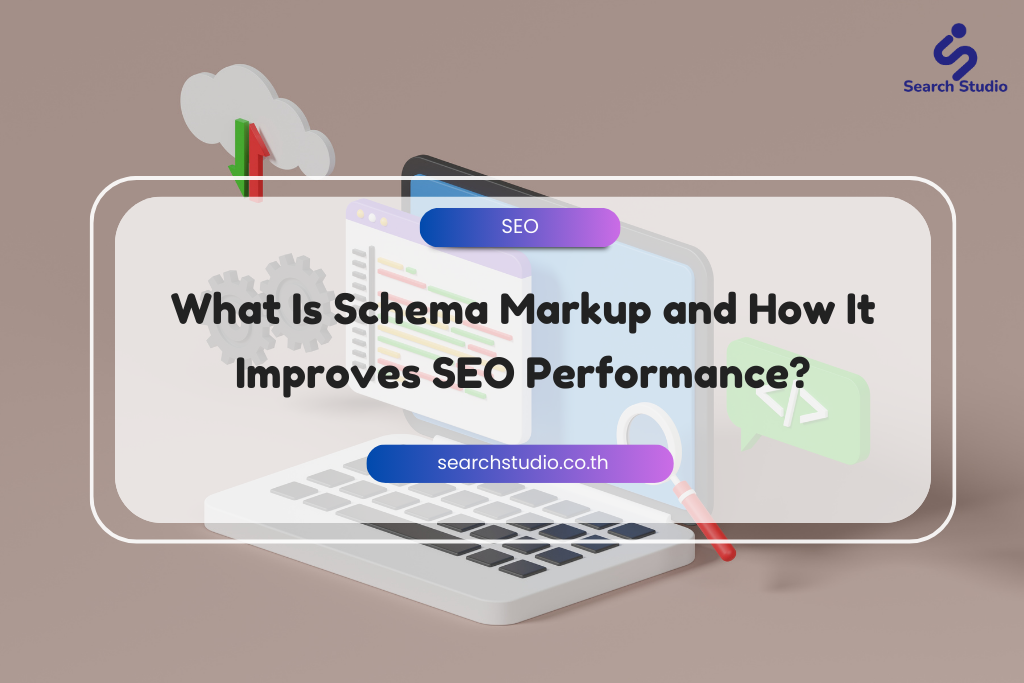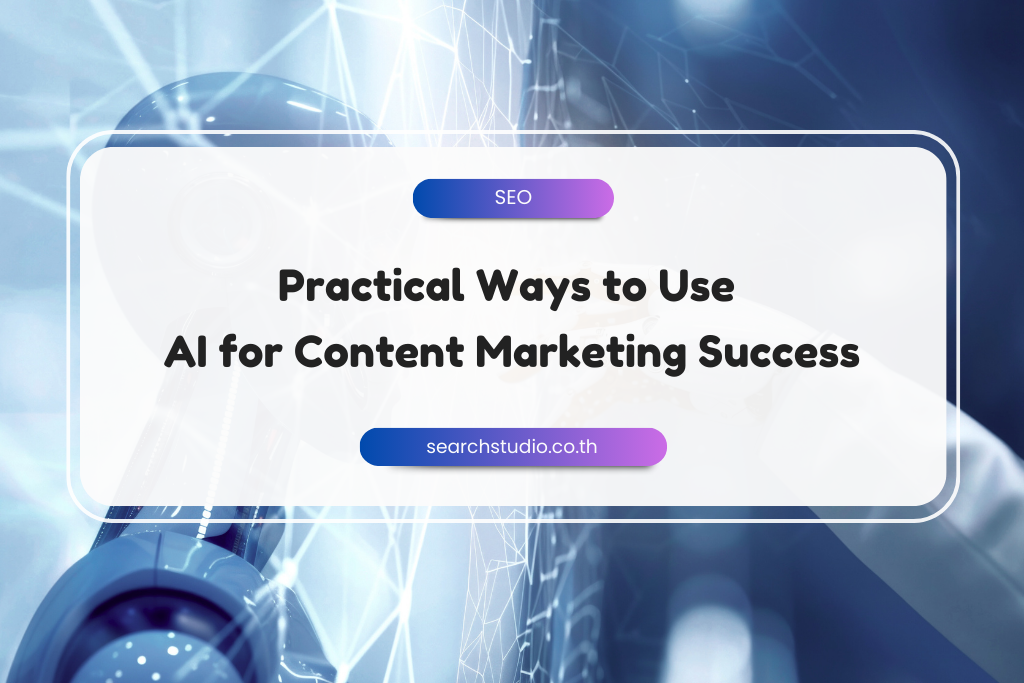As more people turn to AI assistants like ChatGPT, Perplexity, and Google’s Search Generative Experience (SGE), how we search for answers is changing. This is where GEO, or Generative Engine Optimization, comes in. So what is GEO? GEO is the next step in content strategy. It helps your brand get seen by AI-driven tools that summarize and recommend content.
If you want your content to be quoted, referenced, recommended by AI tools, and shown in AI-generated answers, understanding how GEO works is no longer optional. In this guide, we’ll cover what GEO is, how to implement it effectively, and which AI tools can support your GEO strategy.
What is Generative Engine Optimization (GEO)?
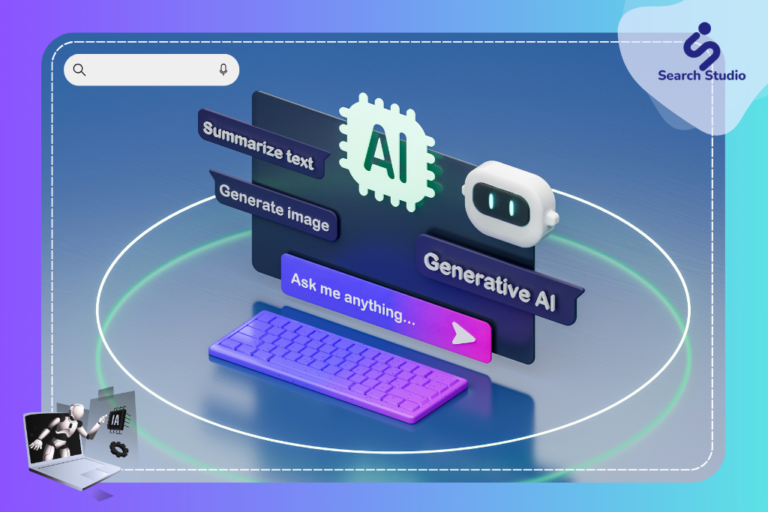
Generative Engine Optimization (GEO) is the practice of improving your content so it’s easily found, understood, and used by AI models. Instead of ranking on Google alone, GEO targets the outputs of AI tools that summarize web content. These tools don’t just list websites, they answer questions. And they pull from the content they trust most.
So the most effective generative engine optimization solution is simply a strategy to make your content relevant, structured, and credible enough for generative engines to notice.
What Is GEO Marketing?
GEO marketing is a related but slightly different concept. It refers to targeting users based on geographic data. However, in the context of generative engines, GEO can also mean marketing through content that AI tools use to influence decisions. For instance, if someone asks an AI assistant, “What’s the best CRM for small businesses?” and your blog is cited, that’s GEO marketing at work.
Why Your Business Should Care About GEO
When people search using AI tools, they often don’t click through to websites. They rely on summarized results. If your content isn’t included in those summaries, you’re invisible. That’s why generative engine optimization strategies are becoming critical. You want AI engines to pull information from your site. That starts with understanding how these systems find and evaluate content. AI looks for structured, informative, and trustworthy material. If your content is thin, vague, or promotional, it will be ignored.
What’s changing is where and how visibility happens. SEO (Search Engine Optimization) helps you rank on a search engine results page. GEO helps you surface inside the response of the engine itself. In this environment, authority being the best answer to a specific question. That means your site needs to function like a high-quality data source: clear, comprehensive, and crawlable.
AI systems don’t browse the web like humans do. They don’t skim headlines or read top to bottom, however, they parse schema, evaluate structured data, and look for consistent citations. If your content lacks clear structure, metadata, or internal logic, it’s likely to be overlooked. That’s why businesses that understand and implement GEO early are positioned to gain an outsized share of visibility across AI-driven platforms.
The Difference Between SEO & GEO
Search Engine Optimization (SEO) and Generative Engine Optimization (GEO) are both essential for digital visibility, but they serve different objectives.
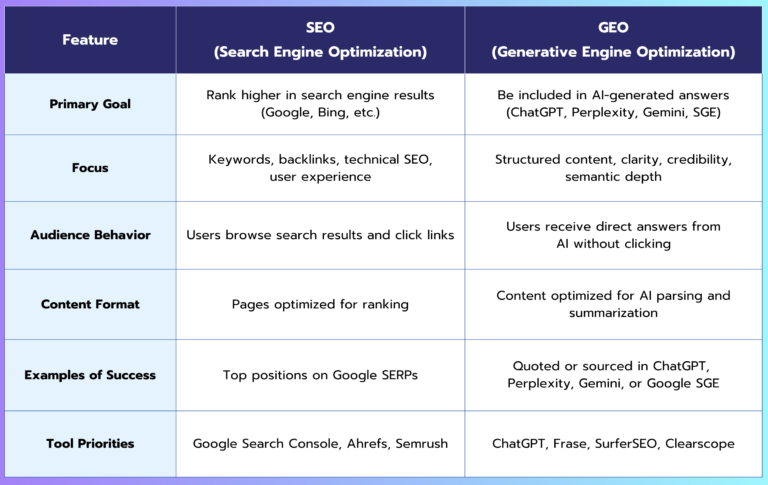
How to Do Generative Engine Optimization
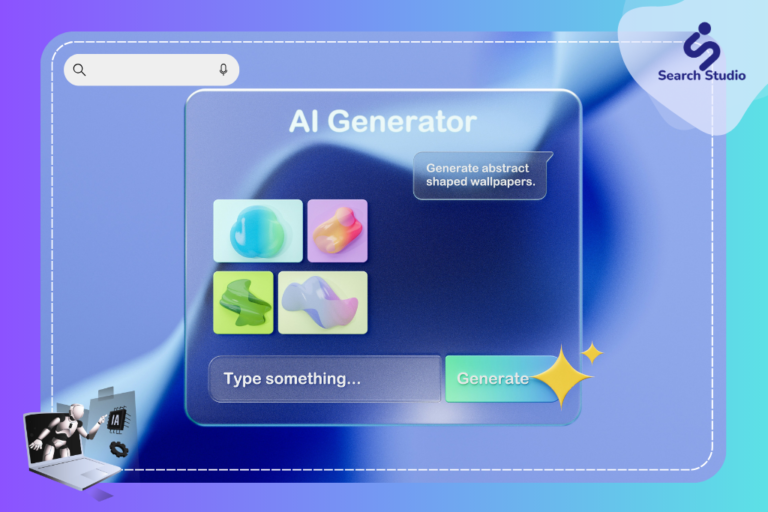
As mentioned, Generative Engine Optimization (GEO) is about making your content so clear, structured, and useful that AI tools choose to reference it. Here’s how to make that happen:
1. Write for Clarity, Not Cleverness
- Answer specific questions directly. If someone asks, “What is B2B SEO?” your content should answer that within the first paragraph.
- Use short paragraphs and clear formatting. Break content into logical sections to make it easier for both users and AI tools to process.
- Use H2s and H3s to organize ideas. AI systems often extract content from these headings for summaries.
2. Build Semantic Topic Clusters
- Group related content. Don’t isolate a single keyword on one page. Build supporting pages around key topics (e.g., “local SEO for small businesses,” “NAP consistency,” “Google Business Profile”) and link them together.
- Use internal links wisely. These help AI understand relationships between concepts and reinforce your site’s topical authority.
3. Cite Reliable Sources
- Link to .gov, .edu, or well-established industry sites when quoting data or claims.
- Use anchor text that reflects the context. For example, instead of linking “click here,” say “according to a Moz study on domain authority.”
- Avoid claims without evidence. AI tools tend to overlook content that isn’t backed by credible sources.
4. Keep Content Fresh and Relevant
- Set a content review schedule. Aim to revisit and update key pages every 3–6 months.
- Add new statistics, case studies, or trend analysis to show ongoing relevance.
- Use last-updated timestamps visibly. AI often factors this into content selection.
5. Use Schema Markup Strategically
- Add structured data using tools like Google’s Rich Results Test. Start with:
- FAQPage for question-and-answer sections
- HowTo schema for step-by-step guides
- Article or BlogPosting schema for editorial content
- Include breadcrumbs and author information to improve trust signals for AI.
6. Strengthen Off-Site Signals
- Get listed in directories like Crunchbase, Product Hunt, or industry-specific listings.
- Encourage organic mentions on Reddit, Quora, Medium, or LinkedIn through useful answers and content sharing.
- Pursue digital PR, guest post, contribute to roundups, or partner with influencers in your niche.
7. Optimize for AI Readability
- Use clear, descriptive headings every 200–300 words.
- Repeat core themes naturally across the page using natural language and avoid repetition that feels forced or keyword-stuffed.
- Think like a language model. Would a tool like Perplexity or ChatGPT copy this paragraph into its response? If not, revise it.
Best AI Tools for Generative Engine Optimization
Want to make GEO easier? These AI tools help you align content with the way generative engines evaluate and present information:
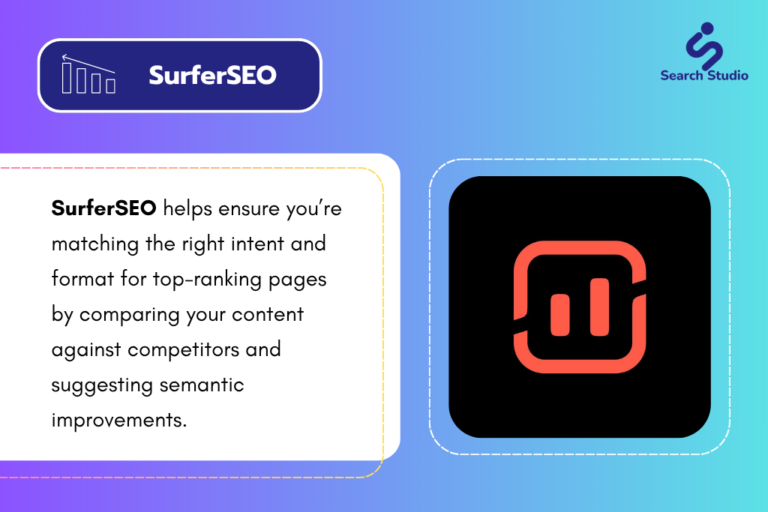
SurferSEO: Optimizes content structure and keyword use. It helps ensure you’re matching the right intent and format for top-ranking pages by comparing your content against competitors and suggesting semantic improvements.
Check it out: https://surferseo.com/
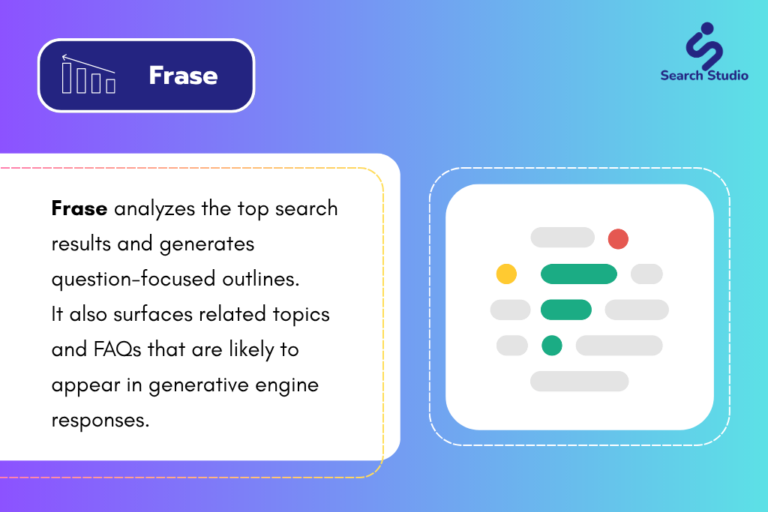
Frase: Designed for answer-driven content. Frase analyzes the top search results and generates question-focused outlines. It also surfaces related topics and FAQs that are likely to appear in generative engine responses.
Check it out: https://frase.io/
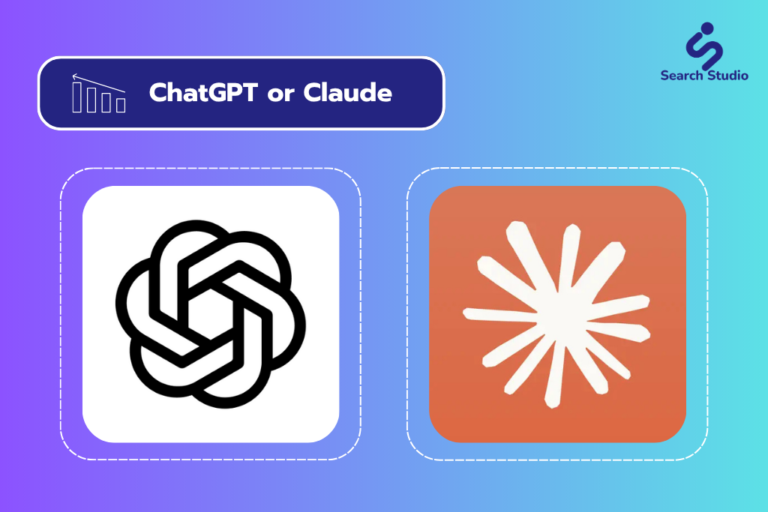
ChatGPT or Claude: These large language models are perfect for simulating how AI tools digest your content. You can paste your article and ask questions like, “What does this page teach?” or “Which sources are cited here?” This helps identify blind spots in clarity and structure.
- Check it out: https://chatgpt.com/
- Check it out: https://claude.ai/
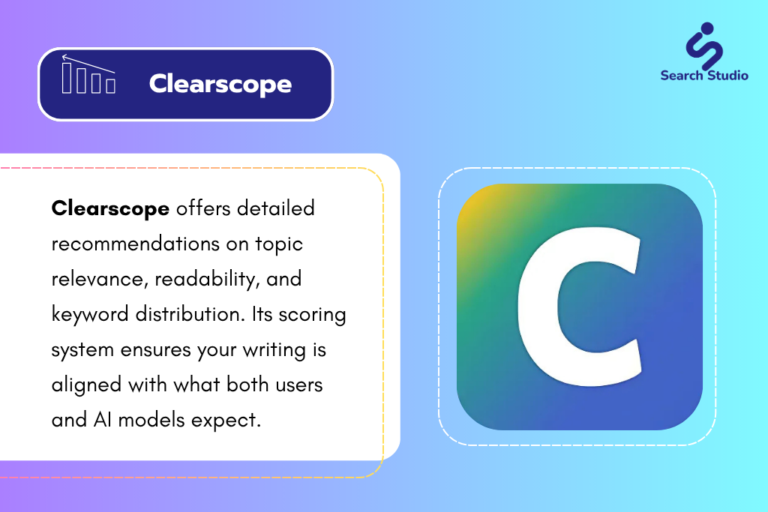
Clearscope: Offers detailed recommendations on topic relevance, readability, and keyword distribution. Its scoring system ensures your writing is aligned with what both users and AI models expect to see in high-quality content.
Check it out: https://www.clearscope.io/
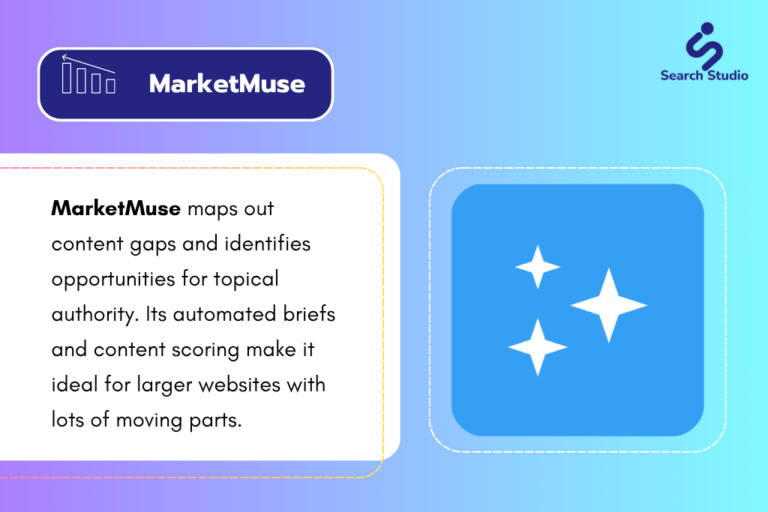
MarketMuse: A power tool for content strategists, it maps out content gaps and identifies opportunities for topical authority. Its automated briefs and content scoring make it ideal for larger websites with lots of moving parts.
Check it out: https://www.marketmuse.com/
Which Generative Engine Optimization is Best for AI?
There’s no one-size-fits-all GEO playbook, but one principle always holds: create content that answers real questions with real substance. If you’re wondering, “What’s the Best Generative Engine Optimization Strategy for AI?”, start by looking at your content from a user perspective.
- Is the content specific and actionable? Generic advice doesn’t get quoted. Unique insights, examples, or data do.
- Are you linking to credible, recent sources? AI models lean on content backed by evidence.
- Is your language clear and to the point? Fluff, jargon, and clickbait dilute your authority.
- Does the page serve a defined purpose? Each piece should answer a question or solve a problem clearly.

Generative Engine Optimization is a strategic shift in how visibility works online. As AI becomes a primary gateway to information, your content needs to be clear, structured, and trusted by the systems delivering those answers.
At Search Studio, a boutique SEO agency in Thailand, we specialize in helping businesses adapt to this shift with practical, performance-focused strategies. If you’re looking to future-proof your blog content, optimize landing pages for AI visibility, or build topical authority in your niche, our team brings a deep understanding of both SEO and GEO best practices. We help your brand become a reliable source for AI-driven platforms.
If your business depends on content to educate, convert, or compete, now is the time to optimize not just for search engines, but for generative engines too. Feel free to contact us for a customized strategy that keeps you ahead of how people search today and tomorrow.



